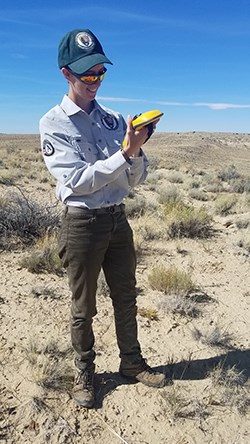
NPS photo by Jack Wood.
Chaco Culture National Historical Park is known for its impressive architecture constructed ten centuries ago, but the canyon also holds remnants of a far older world. Take a moment to look at the sandstone cliffs from which the great house bricks were quarried and you might see ripple marks, clam shell casts, and a vast network of shrimp burrows. The fossils at Chaco represent ten to fifteen million years of life on Earth, during the Late Cretaceous when New Mexico sat on the ever-changing coastline of an inland sea. This ocean, known as the Western Interior Seaway, was home to sharks and giant reptilian predators like mosasaurs and plesiosaurs, as well as ammonites, relatives of today’s squids. On land, the climate was much warmer than it is today, and a tropical lowland swamp supported dinosaurs, crocodilians, and turtles. At the end of the Cretaceous, a mass extinction wiped out much of the flora and fauna. Today, the fossils at Chaco preserve some of the few remains of this ancient ecosystem.

NPS photo by Dana Hawkins.
In 2005, researchers, volunteers, and interns began surveying the diverse paleontological resources of the park and have discovered 70 million-year-old shark teeth, petrified tree stumps, and even dinosaur bones. By 2018, Chaco joined a small handful of National Parks that have surveyed nearly 100% of its land, making a big step forward in protecting and learning from these natural resources. The complete survey report was published in 2019 and is available online. However, the paleo project did not stop there.
To spread awareness for the park’s rich and diverse natural history, Park Service paleontologists created 3D images of fossils in the field. Using a technique called structure-from-motion photography, these fossils were digitized and made accessible as interactive models. Now visitors and researchers alike can view these fossils up close. Since Chaco’s paleontology has not been studied as thoroughly as its archeological marvels, this digital resource increases the potential for unidentified species to be named and for educators to use them as teaching tools in the classroom. Whether you are unfamiliar with Chaco or return every year, you are bound to discover something new in these images, and maybe even develop a love for the park’s ancient ecosystems.
Last updated: October 14, 2020
